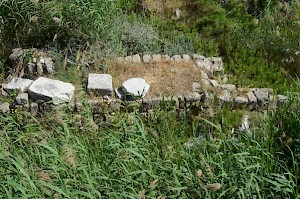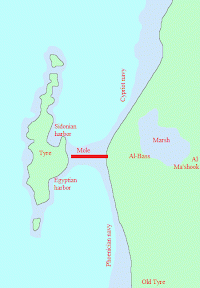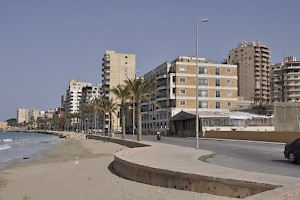The siege of Tyre (332 BCE)
Q815233Siege of Tyre (332 BCE): the most famous of the sieges of Alexander the Great.

From January to July 332 BCE, Alexander tried to take the Phoenician city Tyre, the naval base of the Persians. The town was built on an island, but Alexander ordered a dam to be constructed. Finally, after the Phoenician town Sidon had sent Alexander naval assistance, the city was taken. The Macedonian and Greek soldiers, who were frustrated by the length of the siege, avenged themselves on the populace.
The Roman author Quintus Curtius Rufus, who based his account on earlier, Greek sources, describes the fall of Tyre in section 4.4.10-21 of his History of Alexander the Great of Macedonia. The translation was made by John Yardley.
The siege of Tyre
The men were then given two days' rest, after which they were ordered to bring up the fleet and siege-engines simultaneously so that Alexander could press his advantage at all points against a demoralized enemy.

The king himself climbed the highest siege-tower [which was full of catapults and other siege-engines]. His courage was great, but the danger greater for, conspicuous in his royal insignia and flashing armor, he was the prime target of enemy missiles. And his actions in the engagement were certainly spectacular. He transfixed with his spear many of the defenders on the walls, and some he threw headlong after striking them in hand-to-hand combat with his sword or shield, for the tower from which he fought practically abutted the enemy walls.
By now the repeated battering of the rams had loosened the joints in the stones and the defensive walls had fallen; the fleet had entered the port; and some Macedonians had made their way on to the towers the enemy had abandoned .
The Tyrians were crushed by so many simultaneous reverses. Some sought refuge in the temples as suppliants while others locked their doors and anticipated the enemy by a death of their own choosing. Others again charged into the enemy, determined that their deaths should count for something. But the majority took to the rooftops, showering stones and whatever happened to be to hand on the approaching Macedonians.
Alexander ordered all but those who had fled to the temples to be put to death and the buildings to be set on fire. Although these orders were made public by heralds, no Tyrian under arms deigned to seek protection from the gods. Young boys and girls had filled the temples, but the men all stood in the vestibules of their own homes ready to face the fury of their enemy.

Many, however, found safety with the Sidonians among the Macedonian troops. Although these had entered the city with the conquerors, they remained aware that they were related to the Tyrians [...] and so they secretly gave many of them protection and took them to their boats, on which they were hidden and transported to Sidon. Fifteen thousand were rescued from a violent death by such subterfuge.
The extent of the bloodshed can be judged from the fact that 6,000 fighting-men were slaughtered within the city's fortifications. It was a sad spectacle that the furious king then provided for the victors: 2,000 Tyrians, who had survived the rage of the tiring Macedonians, now hung nailed to crosses all along the huge expanse of the beach.